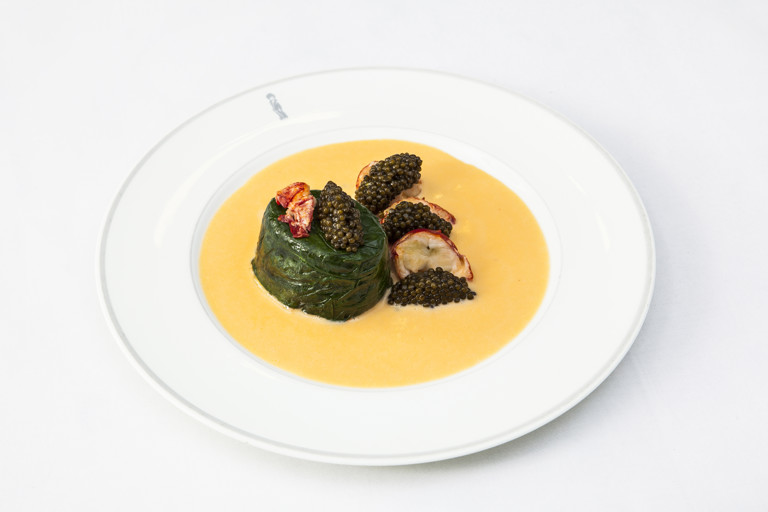Mousselines of lobster with Champagne beurre blanc and caviar
Item 1 of 1
- medium
- 6
- 2 hours 5 minutes
Classical French cooking is famous for its use of luxurious ingredients and indulgent flavours – something this recipe from Michel Roux Jr offers in spades. A delicate spinach-wrapped lobster mousseline comes served with lobster tail medallions, a generous amount of caviar and a pool of rich and buttery Champagne sauce.
You’ll want to brush up on your lobster preparation skills to do this dish justice – take a look at our video guide for more detailed information on how to shell lobsters here.
First published in 2020
discover more:
Ingredients
Metric
Imperial
- 2 hen (female) lobsters, each weighing approx. 300g, with their eggs if possible
- 1 lobster, large, weighing approx. 1.3kg
- 2 egg whites
- 750ml of double cream, chilled
- 150g of spinach, large leaves only and stalks removed
- 300g of butter, room temperature, plus extra melted butter for brushing the moulds
- 50g of caviar, ideally Beluga
- 2 shallots, finely chopped
- 200ml of Champagne
- fine sea salt
SAVE RECIPE
Method
1
If the lobsters are alive when you get them home, then kill them humanely by inserting a needle or sharp knife into the centre of the cross on their heads. Alternatively, you can ask a fishmonger to do this for you
2
Bring 2 litres of water to the boil in a saucepan with 30g of salt. Remove the eggs from the hen lobsters (if there are any) and reserve in the fridge. Rinse the lobsters in cold water, then plunge into the boiling water and cook for 12 minutes. Drain immediately and leave to cool
- 2 hen (female) lobsters, each weighing approx. 300g, with their eggs if possible
3
Remove the meat from the shells, trying to keep the tail meat in large pieces. Cut the tails into medallions and wrap in a damp cloth. Finely dice the remaining lobster meat and set aside
4
Rinse the large lobster in cold water and detach the claws and tail. Using a mallet, crack the claws and take out the meat (if you’re struggling to get the raw meat out of the shells, plunging the lobster into boiling water for 10-15 seconds can help loosen it). Cut open the tail shell with scissors and use a spoon to scrape out the meat. Immediately discard the gritty sac from near the coral in the head – you should get around 400g of raw lobster meat from the large lobster
- 1 lobster, large, weighing approx. 1.3kg
5
Place the meat from the large lobster in a blender or food processor along with the egg whites and 2 teaspoons of salt. Blitz until thoroughly combined and smooth, then rub the mixture through a sieve into an earthenware or stainless steel bowl set in crushed ice
6
Work the mixture with a wooden spoon or spatula, stirring in the double cream a little at a time until it is all mixed in. The texture should be soft and slightly runny. Reserve the mixture in the fridge
- 750ml of double cream, chilled
7
To cook the spinach, blanch the leaves in boiling water for 30 seconds, then drain and plunge into iced water. Dry the leaves by spreading them out flat on a tea towel
- 150g of spinach, large leaves only and stalks removed
8
Preheat an oven to 200°C/gas mark 6. Using a pastry brush, thickly coat the insides of your dariole moulds with melted butter, then line the bases and sides with the dried spinach leaves, ensuring there is plenty of overhang so you can seal the tops
9
Half-fill the moulds with the lobster mousse, then place a very small amount of caviar in the centre with the handle end of a teaspoon (you want to have plenty of caviar leftover to serve). Add a few lobster eggs (if using) and some of the reserved finely diced lobster meat. Top up with more lobster mousse, then fold the spinach leaves over to enclose the filling completely
- 50g of caviar, ideally Beluga
10
Place the filled dariole moulds into a deep baking dish and heat a pan of water to 70°C. Pour the water – ensuring it is the correct temperature – into the baking dish so the water comes halfway up the sides of the moulds. Cover the baking dish with foil, then transfer to the oven and cook for 18 minutes
11
Meanwhile, prepare the sauce. Add the shallots and Champagne to a saucepan and simmer until reduced and slightly syrupy. Take the pan off the heat and beat in a little butter, then return to a low heat and beat in the remaining butter, a little at a time. When the butter becomes creamy and begins to foam, crush any remaining lobster eggs with the flat of a knife and stir them into the sauce, which will give it a delicate orange tinge. Season to taste and keep warm
12
Wrap the reserved lobster medallions in foil and, once the mousselines are cooked, place in the oven to warm through
13
To serve, very carefully unmould the lobster mousselines onto serving plates (they will be very fragile). Place the warmed lobster medallions alongside, and any remaining diced lobster meat on top of the mousselines. Finish with small quenelles of caviar, then pour the warm sauce around the plate (ideally through a conical sieve) and serve immediately
Get in touch
Please sign in or register to send a comment to Great British Chefs.


